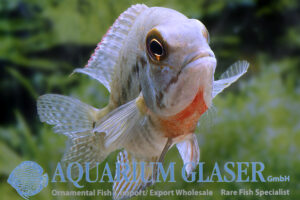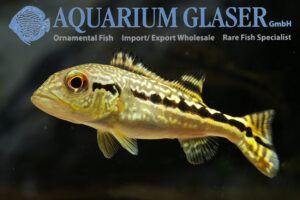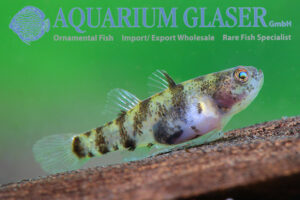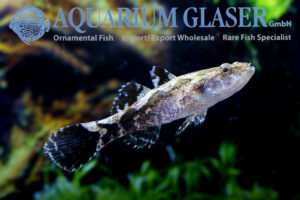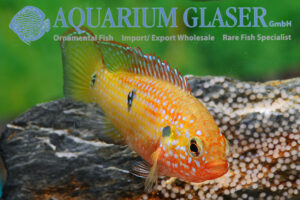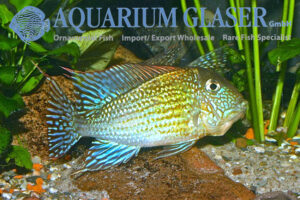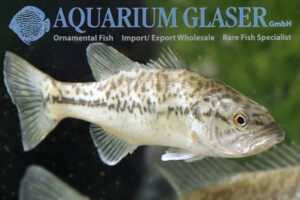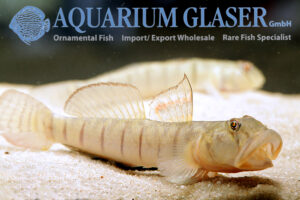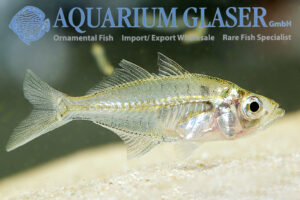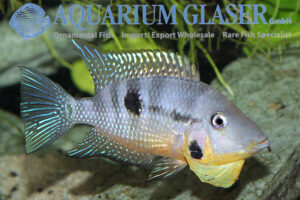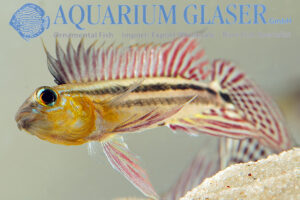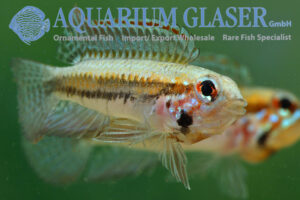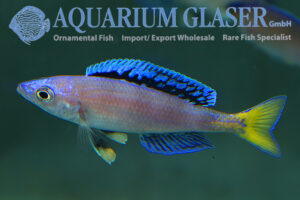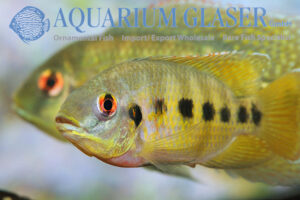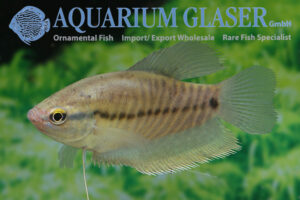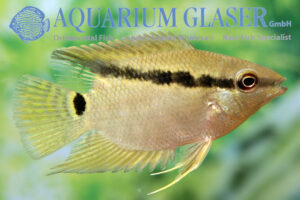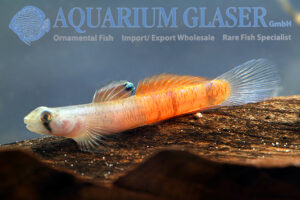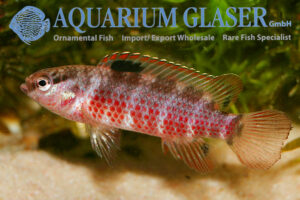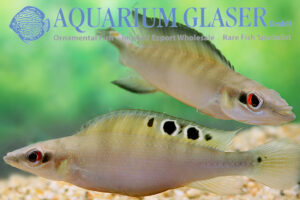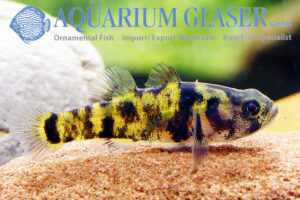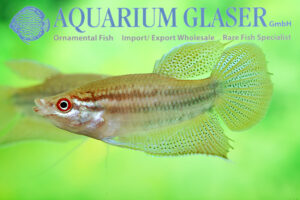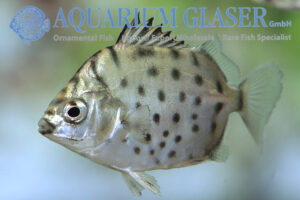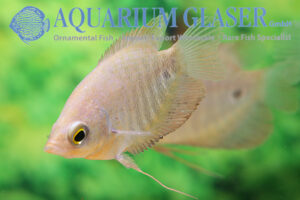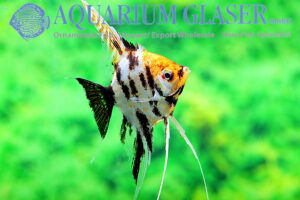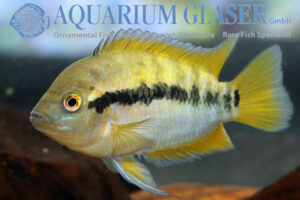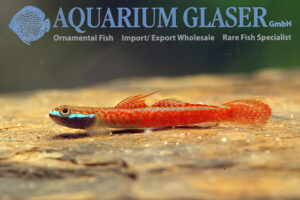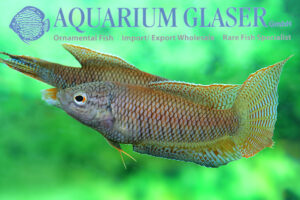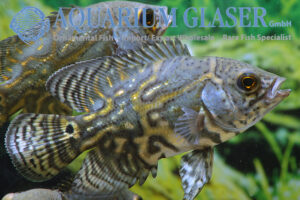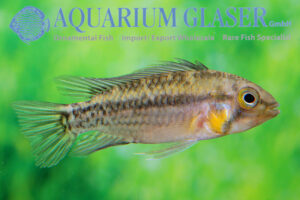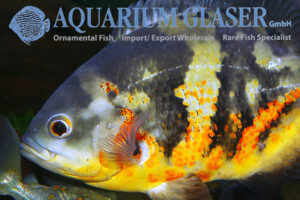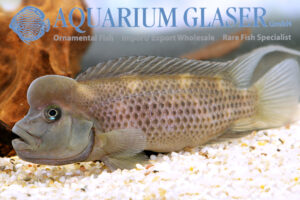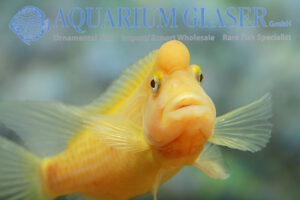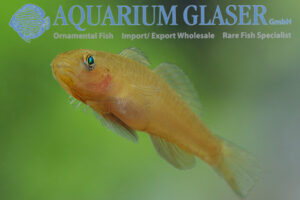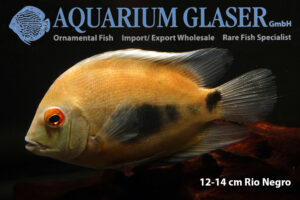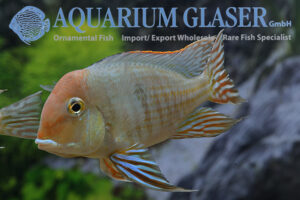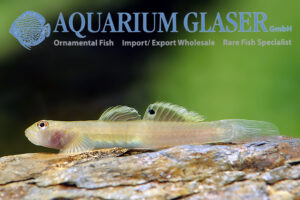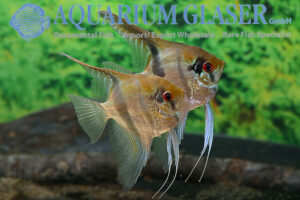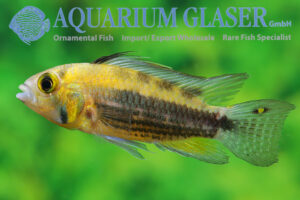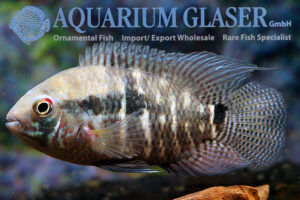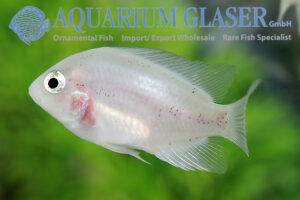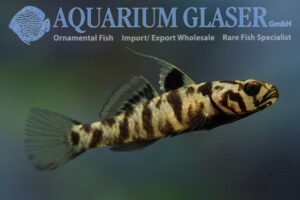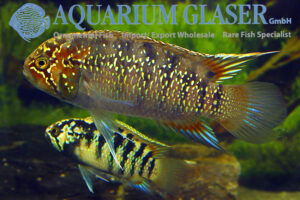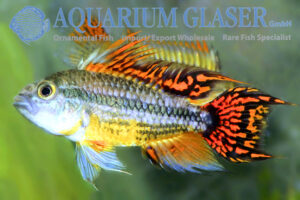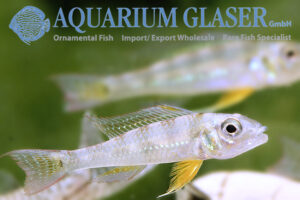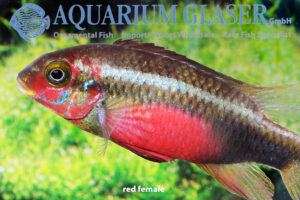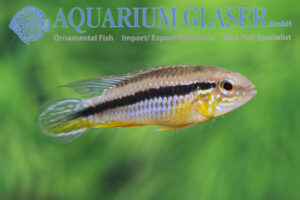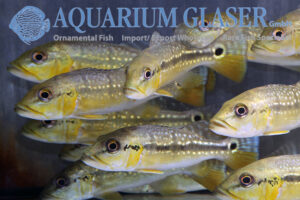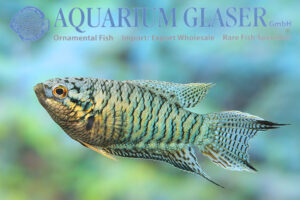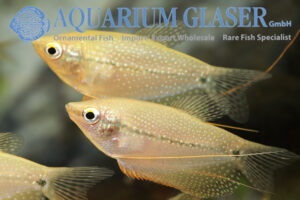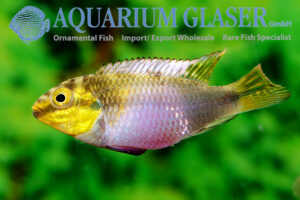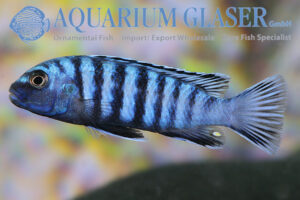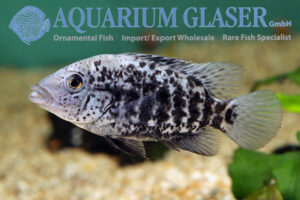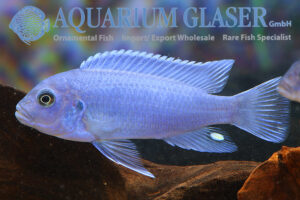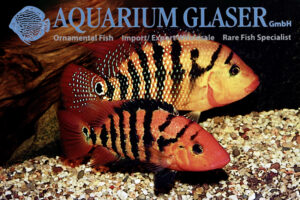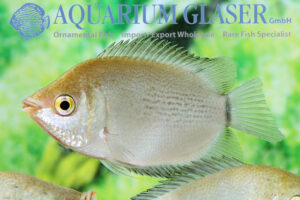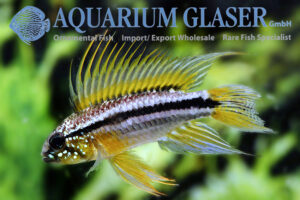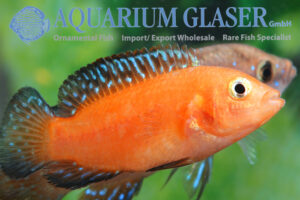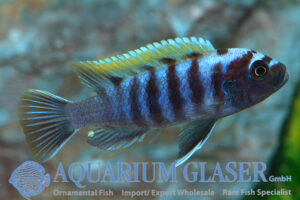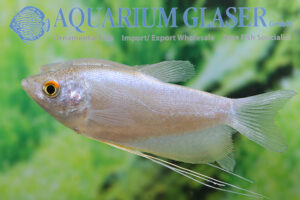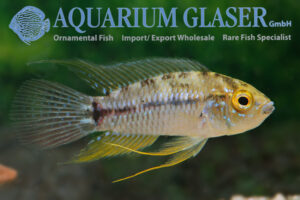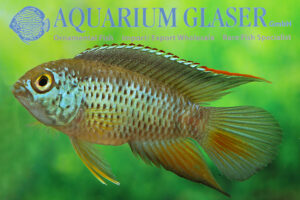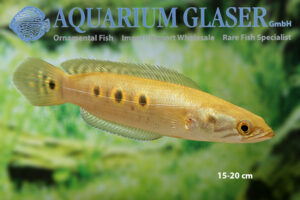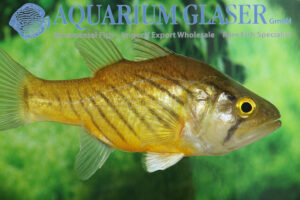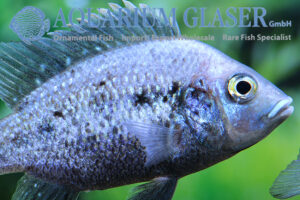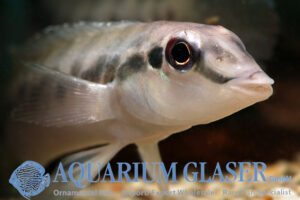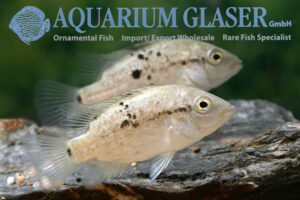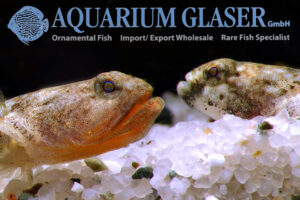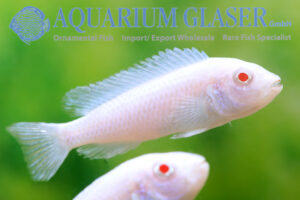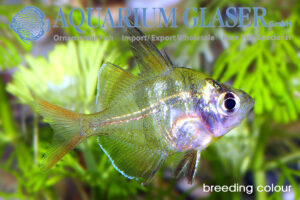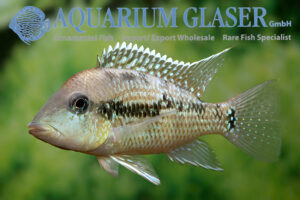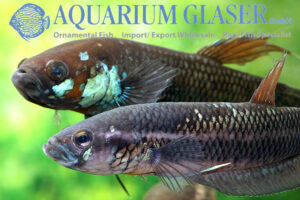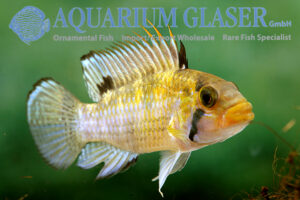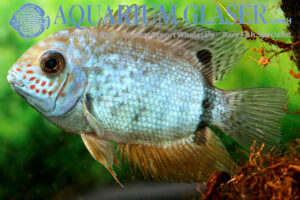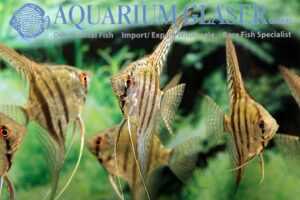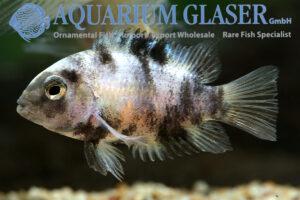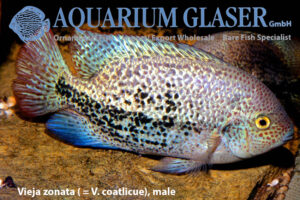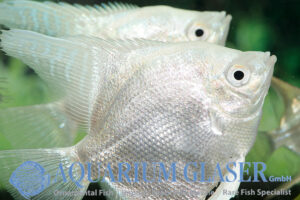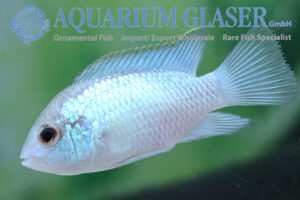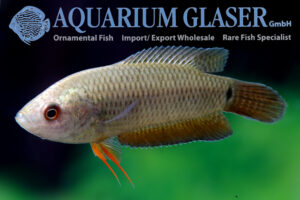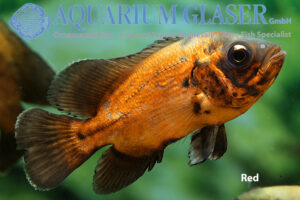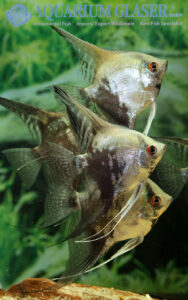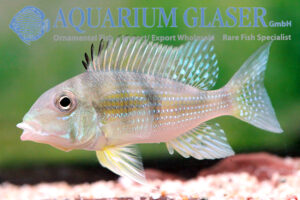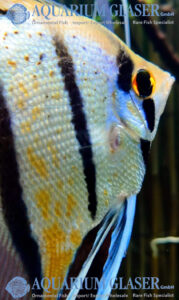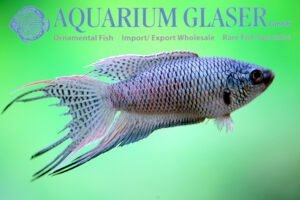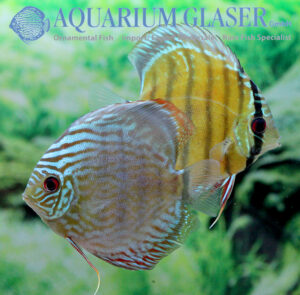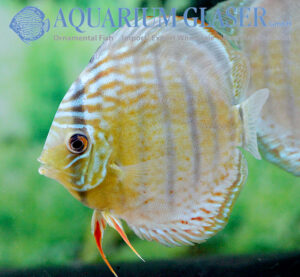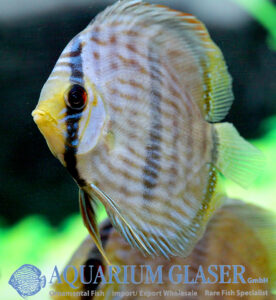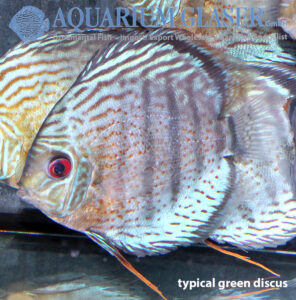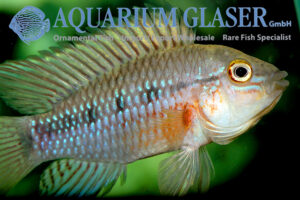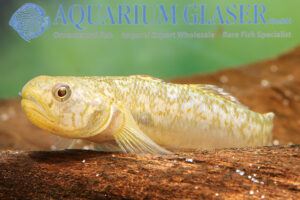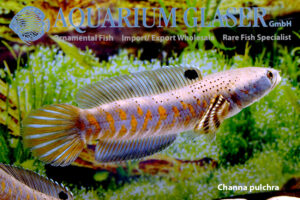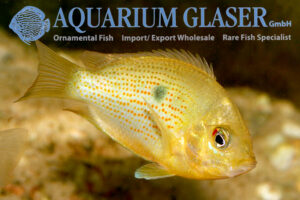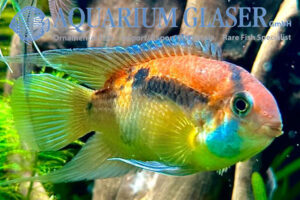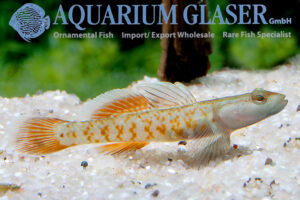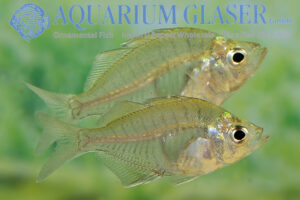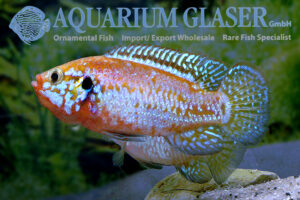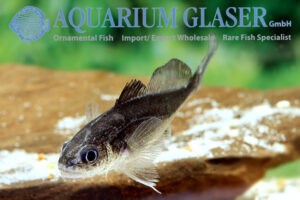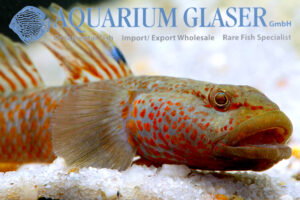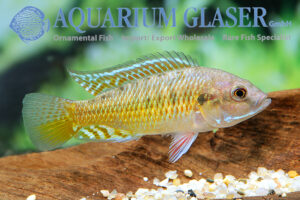Hoplarchus psittacus is one of the very rarely available large cichlids from South America, which is called “Acara paragua” – parrot cichlid – by the indigenous population because of its red breast, which is reminiscent of the colors of some parrots in the Amazon region. Hoplarchus psittacus is the only species of the genus. It […]
25. Perchlike fishes (905)
-
-
Cichla sp. Royal Silk
People with large aquariums often also want large fish. It’s amazing how many people with large or even very large aquariums there are nowadays; otherwise it’s hard to explain why the Tucunaré or peacock cichlids of the genus Cichla, which used to be considered specialist fish and only develop their most beautiful coloration from around […]
-
Brachygobius mekongensis
In the genus Brachygobius we find some of the smallest freshwater goby species. One of these dwarfs is B. mekongensis, a species that was only scientifically described in 2000. The late scientific recording of this species, which is widely distributed in the Mekong River basin in Laos, Cambodia and Thailand, is due to the fact […]
-
Oxyeleotris marmorata
Most gobies live in the sea. And most gobies stay small, usually less than 10 cm. So Oxyeleotris marmorata, the Marbled Sleepergoby, is an exception in more than only one respect. The species is a giant among the gobies and becomes more than 50 cm long. And usually it lives in pure freshwater; only occasionally […]
-
Rubricatochromis guttatus “Yellow Sunshine”
The red jewel cichlids (Rubricatochromis, formerly Hemichromis) have been appearing in thermal waters in Central Europe for decades and seem to feel very much at home there. The first documented cases date back to the 1970s from the warm streams of Villach (Carinthia, Austria), but in the meantime they have appeared almost everywhere where the […]
-
Geophagus mirabilis
All Geophagus species are beautiful, but some are more beautiful than others. Since 2009, aquarists have known of a beautiful earth eater that only occurs in the Rio Aripuanã catchment in Brazil. Accordingly, the species was initially referred to as Geophagus sp. “Aripuana”. In January 2015, the beautiful species was scientifically described for the first […]
-
Micropterus salmoides
Large mouth bass (Micropterus salmoides) originally come from the eastern United States where they inhabit waters from the Canadian border to Mexico. Since the 1880s, they have been introduced to Europe (and elsewhere) as sport and food fish and are now found wild in many areas. They are among the 100 most dangerous invasive species […]
-
Awaous flavus ( = A. strigatus)
The butterfly goby (Awaous flavus, formerly known aquaristically under the synonym A. strigatus) has a large distribution area along the Atlantic coast of South America. They are found in the lower reaches of rivers in Brazil, Guyana, Suriname, Venezuela, Colombia and on islands off the coast. Adults of this species, which is a maximum of […]
-
Chanda nama
Until the 1950s, all aquaristically known species of glass perch were known under the genus name “Chanda”. The first major regrouping was carried out in 1955 by Fraser-Brunner, who revived the (old) genus Ambassis (with 20 species), placed the species nama in the monotypic genus Hamiltonia (i.e. only one species is assigned to it), established […]
-
Thorichthys affinis
“The unexpected often happens” says the well-known proverb. That’s what happened to us with Thorichthys affinis. Some time ago we received juveniles of – according to the breeder – Thorichthys meeki, the firemouth cichlid. The 3-4 cm long juveniles didn’t have much to offer in terms of color, but they were extremely harmonious in terms […]
-
Apistogramma bitaeniata Blue wild
We have already reported on Apistogramma bitaeniata several times, please see hhttps://www.aquariumglaser.de/en/25-perchlike-fishes/apistogramma-bitaenata-brazil/ or https://www.aquariumglaser.de/en/fisharchive/apistogramma-bitaeniata-putumayo-4/. This species is without doubt one of the most beautiful dwarf cichlids around. We have recently received a locality variant from Brazil that differs in color from the specimens we normally obtain from there. In the light of the torch, we […]
-
Apistogramma psammophila
The two-banded dwarf cichlid, Apistogramma diplotaenia, is one of the dream fish of many Apistogramma lovers. The species originates from the Rio Negro drainage in Brazil. Unfortunately, this fish is also one of the most demanding species of the genus and even minor carelessness – e.g. a missed water change and the resulting increase in […]
-
Cyprichromis leptosoma “Mpulungu”
Cyprichromis and Paracyprichromis are very special mouthbrooding cichlids from Lake Tanganyika. The animals sometimes live in huge shoals and feed on small animals that they pick out of the free water column. To attract the attention of the females, the males can be very brightly colored. They do not occupy actual territories. The females, on […]
-
Pelmatolapia mariae
In contrast to the larger Central American cichlids of the Cichlasoma relationship, the medium-sized African cichlids of the Tilapia relationship, which are ecologically quite similar to them, have never managed to become widespread in aquariums. The reasons for this lie in the geographical proximity of Africa to Europe. When aquarium keeping became widespread around 1900 […]
-
Trichogaster pectoralis
The snakeskin gourami (Trichogaster pectoralis) is the largest and most peaceful species of gourami. The animals can become 20-25 cm long and are therefore in their homeland Southeast Asia also estimated food fish. However, we prefer to enjoy their calm nature and beautiful coloration. For years there has been a dispute about the correct genus […]
-
Mesonauta egregius
The flag cichlids (Mesonauta) are beautiful and peaceful, medium-sized cichlids that reach a length of 12-15 cm. In the wild they usually live together with angelfish (Pterophyllum), which they also resemble in terms of behavior and general requirements in the aquarium. As with the angelfish, the sexes are indistinguishable in younger animals. In older specimens, […]
-
Sicyopus zosterophorus
The gobies (Gobiidae) are probably one of the most species-rich families of fish with over 2,000 species (currently accepted: around 1,500 species). Many gobies live in the sea, but gobies are often the most common fish in the freshwater of oceanic islands. In these cases, they are usually species that live as adult fish in […]
-
Badis singenensis ( = sp. Buxar)
Badis singenensis ( = sp. Buxar) A beautiful, small chameleon fish (Badis) originates from the north of India, which has a reduced swim bladder as a special feature within the genus. As a result, it is very bottom-bound and moves around somewhat hopping. The maximum length of this species is approx. 4-5 cm including the […]
-
Wallaciia regani (formerly: Crenicichla regani) Tapajós
Cichlids are referred to as dwarf cichlids if their total length – including the caudal fin – does not exceed 10 cm. As many cichlids grow considerably larger and then also have corresponding space requirements in terms of housing, dwarf cichlids are particularly popular in the aquarium hobby. All pike cichlids of the genus Wallaciia […]
-
Brachygobius sp. Ocelot
Again we could import this new species of dwarf bumble-bee goby. This tiny fish becomes only 2 cm long. It cannot be applied to any described species so far. The fish have been collected in Indonesia. In Brachygobius, one very important feature for determination is the question wether the predorsal region is scaled or naked. […]
-
Trichopsis vittata
The Croaking Gourami (Trichopsis vittata) is perhaps the most common small fish in South East Asia. It grows to 4 – 6.5 cm long. It can be found almost everywhere, except in strongly flowing waters and in the mountains. Freshly caught, the Croaking Gourami is usually very attractively coloured and shimmers in different shades of […]
-
Selenotoca multifasciata (S. papuensis)
There are two genera of argus fish or scats, Scatophagus and Selenotoca. Most authors currently only recognize two species in Scatophagus and one in Selenotoca, in Scatophagus the species S. argus and S. tetracanthus and in Selenotoca the species S. multifasciata. However, there are certainly considerably more species, and in Selenotoca there is probably at […]
-
Osphronemus goramy
Most people only know giant gouramis (Osphronemus goramy) from the zoo. There, these somewhat overgrown-looking animals (but that’s the way it should be) – the largest labyrinth fish of all – usually swim peacefully in the company of other large fish from Southeast Asia. However, the juvenile fish not only look completely different, but also […]
-
Pterophyllum Angelfish Red Head Marble
In the majority of cases, the aim of breeding forms is to develop a type that is as uniformly colored and physically developed as possible. In other words: ideally, all animals of a particular breeding line should look the same. This is not the case with the marbled angel and the red-headed marbled angel developed […]
-
Herotilapia multispinosa
This medium-sized cichlid – males can grow to a maximum length of 12 cm, females always remain 3-5 cm smaller – originally comes from Central America (Nicaragua, Costa Rica, Honduras). It is a real classic among aquarium fish and was at its peak popularity in the 1970s. Although the name “rainbow cichlid” given to them […]
-
Stiphodon annieae
Neon gobies of the genus Stiphodon are really wonderful aquarium fish. They have an interesting behavior, remain small, are not particularly demanding and the males are often beautifully colored. From an aquarium point of view, they have only one disadvantage: as the larvae develop exclusively in the sea, raising them presents the same difficulties as […]
-
Macropodus erythropterus
The paradise fish (Macropodus) can be roughly divided into three groups: the black paradise fish with the described species M. hongkongensis, M. erythropterus, M. lineatus, M. minnanensis, M. oligolepis, M. phongnhaensis, M. spechti, M. tramiensis and M. yeni, the blue-red paradise fish with the described species M. baviensis, M. chinensis, M. filamentosus, M. opercularis and […]
-
Astronotus mikoljii
Of the seven scientifically described species of Astronotus, only two are currently recognized by most ichthyologists, namely A. crassipinnis and A. ocellatus; however, a third, A. zebra, is so distinctly different in color from the others that there is little doubt as to its validity. Now a new name has been established: the Oscar from […]
-
Apistogramma salpinction
In the 1980s, anyone interested in the dwarf cichlids of the genus Apistogramma did not need to know more than 10 species. Today (2025), this genus is the most species-rich cichlid genus of all, with 94 accepted species plus numerous species that have not yet been scientifically recorded. The majority of the newly discovered species […]
-
Astronotus rubroocellatus Rio Negro
The scientific assessment of the various species within the genus Astronotus varies greatly, with most scientists only accepting three species, namely A. crassipinnis, A. ocellatus and A. mikoljii, which was only described in 2022. Others believe that there are many more species and that the genus urgently needs a scientific revision. The species compressus (Peru, […]
-
Steatocranus casuarius
The humphead cichlids (Steatocranus) are among the most interesting cichlids in Africa. In adaptation to their way of life in nature – they colonize boulder bottoms in the area of rapids – they have reduced their swim bladder and cannot float freely in the water without making swimming movements with their fins. There are eight […]
-
Steatocranus casuarius Gold
Yellow or gold coloration is generally widespread in fish and, although the animals affected by the corresponding mutation are very conspicuous and can therefore be easily preyed upon by predators, they also occur from time to time in nature. The goldfish is such a xanthorist (xanthorism is the technical term for this mutation). Among cichlids, […]
-
Mugilogobius rexi
This small goby is a free swimming species, in contrast to most of the other gobies. Maximum length is about 4-5 cm. Territorial males become bright yellow and also develope larger fins with dark bands. Females are much paler in coloration and have translucent fins. The species is restrictet to Sulawesi and even on that […]
-
Uaru amphiacanthoides
The triangle cichlids (Uaru) are a small genus of cichlids in terms of the number of species, with only two scientifically accepted species: U. amphiacanthoides from the Amazon basin and upper Orinoco (Brazil and Colombia) and U. fernandezyepezi from the Rio Atabapo (Venezuela). Both species reach a total length of 20-30 cm and are therefore […]
-
Geophagus pyrocephalus ( = Tapajós Red Head)
Since the end of the 1980s, a beautifully colored Geophagus from the closer relationship of G. altifrons and G. surinamensis has been known, which differs from almost all other Geophagus species by an orange or red forehead. This characteristic affects both sexes from the onset of sexual maturity, which is the case at around 8-10 […]
-
Lentipes ikeae
The goby subfamily Sicydiinae currently comprises nine genera with 121 species. They are all current-loving animals that occur in nature mainly in clear streams and feed on growth and small animals. Larval development takes place in the sea. Some neon gobies of the genus Stiphodon are particularly popular, representatives of other genera are rarely found […]
-
Pterophyllum “Rio Nanay Type3”
The systematics of the angelfish (Pterophyllum) is poorly understood. Only three species are generally recognized, namely P. altum, P. leopoldi and P. scalare, but there are undoubtedly many more. The “field-forest-and-meadow” scalar of the aquarium hobby in its countless breeding forms is a hybrid for which it makes no sense to give it a scientific […]
-
Apistogramma cacatuoides Yellow wild
The Cockatoo Dwarf Cichlid is one of the most popular members of the genus Apistogramma and found in petshops all over the World. Almost exclusively bred specimens of very colourful sports are traded. These do not appear in the wild. However, “the” wild form of A. cacatuoides does not exist at all. Like so many […]
-
Cichlasoma pusillum
Cichlids identified as Aequidens portalegrensis have been kept and bred in the aquarium since 1913. The German common name was “Streifenbuntbarsch” ( = striped cichlid) because the fish can show numerous vertical stripes in the rear half of the body. As there is a very nice photo by Paul Unger from the 1930s of a […]
-
Vieja fenestrata White & Marbled
The Central American large cichlids of the genus Vieja (synonym: Paratheraps) were, like so many others, previously classified as Cichlasoma. In the 1980s and 1990s, these fish enjoyed relatively great popularity among cichlid enthusiasts who traveled to their Central American habitats and brought back many new findings (and a few little fish). The species Vieja […]
-
Mugilogobius adeia
This strikingly beautiful dwarf goby, which is endemic to Lake Matano on Sulawesi (formerly Celebes), was only scientifically described in 1992, although this lake has long been known as the focus of independent evolution and has been the subject of much research. The earliest findings probably date back to 1989, when Arthur Werner and Maurice […]
-
Ivanacara adoketa ( = Nannacara a.)
This cichlid, which only occurs in a narrowly defined area on the middle Rio Negro and was only scientifically described as Nannacara adoketa in 1993, was for a long time one of the absolute dream fish of cichlid enthusiasts. The initially very few imported fish were mostly exported to Japan and insane prices were demanded […]
-
Apistogramma cacatuoides Double Red
Of course this beautiful breeding form of the cockatoo dwarf cichlid is not a novelty, but such beautiful specimens, as those, which we just received from a German breeder, are a rarity! For our customers: the animals have code 617803 on our stocklist. Please note that we only supply wholesalers. Text & photos: Frank Schäfer
-
Biotoecus dicentrarchus
The dwarf cichlids of the genus Biotoecus were shrouded in mystery for decades. The first species, B. opercularis, was scientifically described as early as 1875. It originated from the Amazon River basin in Brazil, a well-collected area for aquaristic purposes, and yet the first import was not accomplished until the mid-1980s and early 1990s. The […]
-
Pelvicachromis sacrimontis ( = P. pulcher RED wild)
The kribensis cichlid (Pelvicachromis pulcher), also known as the king cichlid, is the most popular dwarf cichlid from Central Africa. In the wild, it colonizes large areas in the Niger River basin. It is mainly bred in the hobby. Like so many dwarf cichlids, P. pulcher is also polychromatic, i.e. it occurs in different color […]
-
Apistogramma gephyra Santa Isabel
Since its scientific description in 1980, this dwarf cichlid has been the subject of heated debate among enthusiasts. Some consider it to be another color variant of Apistogramma agassizii, while others are certain that it is a separate species. Both parties are probably right; there is no doubt that Apistogramma gephyra and A. agassizii are […]
-
Cichla mirianae FOGO
The Peacock basses of the genus Cichla are among the most popular food fish in South America. The animals grow large (30-60 cm, some even up to 100 cm) and have firm, tasty meat with few bones. They are also highly sought after as game fish and anglers travel long distances to catch certain tucunaré […]
-
Macropodus “Blue Tiger“
It is only very recently that we have begun to realize that the diversity of species of paradise fish (Macropodus) is much greater than we thought possible. Basically, three main groups can be distinguished in this genus, whose representatives are at home in China, Vietnam and Korea: Round-tailed paradise fish (M. ocellatus and related species), […]
-
Trichogaster leerii WILD JAMBI
Wild-caught pearl gourami (Trichogaster leerii or Trichopodus leerii) are hardly ever available on the market. In fact, the exact distribution of this gourami species, which is present in the hobby since 1933 and has never disappeared since then, is more anecdotal than scientifically known. It is certain that this species is found on the Malay […]
-
Pelvicachromis subocellatus “Moulondo”
The dwarf cichlids of the Pelvicachromis genus, in the form of P. pulcher, are the most popular cichlids from Africa. They are colorful, relatively peaceful, adaptable and have a very interesting family life. Pelvicachromis have a mother-father family in which the more colorful female is responsible for caring for the spawn laid in a cave […]
-
Chindongo elongatus (formerly Pseudotropheus elongatus)
The former large genus Pseudotropheus is currently divided into four genera: Pseudotropheus, Maylandia, Tropheops and Chindongo. The type species of the genus Chindongo, C. bellicosus, which was described together with the genus in 2016, is one of the most combative mbuna of all. The species name “bellicosus” means “belligerent”! Chindongo includes the species C. ater, […]
-
Nandopsis haitiensis (2)
A few weeks ago we introduced you to the cichlid Nandopsis haitiensis, which is very rarely on sale. Unfortunately, we were only able to illustrate this post with pictures of the somewhat inconspicuously colored juveniles (https://www.aquariumglaser.de/en/fisharchive/nandopsis-haitiensis-2/). However, we have set a few animals aside and they have now developed so well that they are already […]
-
Maylandia callainos Blue/Blue
The zebra cichlids of Lake Malawi (genus Maylandia, synonym: Metriaclima) are still very popular due to their bright colors. In nature, many species are polychromatic. This means “multi-colored” and means that highly differently colored individuals can occur within a population. In M. callainos, the males are cobalt blue (“cobalt zebra”) and develop an intense, brilliant […]
-
Mesoheros festae (formerly: Cichlasoma festae)
The magnificent, large (males up to 35 cm, females up to 30 cm) tiger cichlid (Mesoheros festae) used to be a fairly frequent guest in the aquarium. Together with Andinoacara rivulatus (formerly: Aequidens rivulatus), it was one of the top exports from the Pacific side of Ecuador. M. festae was called “Red Terror”, A. rivulatus […]
-
Helostoma temmickii GREEN
The kissing gourami (Helostoma temmickii) is a very popular ornamental fish for larger aquaria due to its unusual “kissing” behavior. Almost exclusively the pink-colored breeding form is available in the trade (see https://www.aquariumglaser.de/en/25-perchlike-fishes/helostoma-temmickii-2/), as this variant is bred in huge quantities as an edible fish. The pink form is much easier to see than the […]
-
Apistogramma bitaeniata “Putumayo”
Apistogramma bitaeniata is already one of the most beautiful Apistogramma species of all, but the local variant from the Rio Putumayo in Peru goes one better. The males with their huge fins are truly breathtaking. The females look almost underdeveloped in comparison. And yet all this splendor serves only to impress the delicate sex… The […]
-
Rubricatochromis exsul ( = Hemichromis exsul)
The red jewel cichlids (Rubricatochromis, formerly classified as Hemichromis) are without doubt among the most beautiful fish in the world, at least some of them. If they weren’t such excellent parents, who regard every other fish in the aquarium as an enemy of their young and beat them up as a precautionary measure during the […]
-
Maylandia emmiltos
The very first Lake Malawi cichlids came from the group of rock-dwelling cichlids, called Mbuna after a local name, in the late 1950s and early 1960s, including a fish identified as Pseudotropheus zebra in 1964. Today we know dozens of species from this zebra complex, which are often only distributed very locally, but sometimes also […]
-
Trichogaster microlepis ( = Trichopodus microlepis)
Fish for romantics – does that exist? Occasionally! One of them is certainly the moonshine gourami, Trichogaster microlepis. Its popular name says it all. Although the animal is only silvery-white, its tiny scales give it a very peculiar appearance, as if wrapped in silk. Color always means: communication with conspecifics and bright colors are very […]
-
Apistogrammoides pucallpaensis
The dwarf among the little ones: Apistogrammoides pucallpaensis from the upper Amazon in Colombia and the Rio Ucayali in Peru is one of the smallest cichlid species of all. We obtain our animals from Peru. In the literature, the maximum sizes given are 5 cm for males and 4 cm for females. However, these must […]
-
Nannacara anomala
Here’s another animal from the “been in the aquarium forever but still beautiful” department! Nannacara anomala, the Golden Dwarf Cichlid from Guyana, has already delighted our grandfathers. We currently have exorbitantly colored animals in stock, which we call “Red”. They come from a breeder who has really put a lot of love and ambition into […]
-
Channa pleurophthalma
We regularly have perhaps the most beautiful snakehead fish in stock: Channa pleurophthalma. This species, which is found on the Greater Sunda Islands of Sumatra and Borneo and inhabits lakes and rivers there, grows to around 40 cm in length. In contrast to most other snakeheads, they like to swim a lot in open water. […]
-
Glossamia wichmanni
The mouthbrooding freshwater cardinalfish (Glossamia) are particularly rich in species on New Guinea. Of the total of 11-12 currently accepted species, 10-11 occur on New Guinea, 9-10 even only exist there. Only one species is known exclusively from Australia and another occurs on New Guinea and in Australia, namely G. aprion (see https://www.aquariumglaser.de/en/25-perchlike-fishes/glossamia-aprion-2/) Probably the […]
-
Ptychochromis oligacanthus
The Red List of endangered animal and plant species is getting longer and longer. The cause is almost invariably the destruction of the natural habitat. In the case of freshwater fish, species with a small distribution area are always particularly endangered. In addition to factors such as environmental pollution, deforestation and water extraction for agriculture, […]
-
Teleocichla preta
The cichlids of the genus Teleocichla are very closely related to Crenicichla. They remain relatively small, the T. preta discussed here is one of the largest species with a maximum length of 15 cm. The swim bladder is greatly reduced in Teleocichla. Without active swimming movements, they cannot stay afloat. Ecologically, the Teleocichla could be […]
-
Nandopsis haitiensis
Although the current classification of the cichlids from Central America, formerly grouped together under Cichlasoma, has been around for a few years now, many genus names have been slow to catch on in the hobby. The main reason for this is, of course, that the large cichlids of Central America are currently only kept and […]
-
Schismatogobius risdawatiae
The dragonet gobies (Schismatogobius) are small species of freshwater gobies, that reach between 3 and 5 cm length. They live in small rivulets near the coast but above the tide on sandy bottoms. Here they burry themselves very fast if necessary. The larvae devolop – as far as this known – in the sea. The […]
-
Chindongo socolofi “Albino” ( = Pseudotropheus socolofi)
The question of whether an ornamental fish species is particularly popular can often be answered with “yes” if breeding forms exist. Breeding forms, whose characteristics either do not occur at all in nature or only occur extremely rarely in individual specimens, usually only arise when the natural form is bred on a large scale. The […]
-
Parambassia lala
The Indian glass perch (Parambassia lala, often placed in the monotypic genus Pseudambassis) is actually an old acquaintance (first introduction: 1905), but an incredible amount of nonsense has been and still is spread about it. For example, the rumor persists that the species is a brackish water fish. But it is not, it is only […]
-
Geophagus sp. Alto Sinu
In 2016, French aquarists in Colombia discovered a new eartheater, which they named after the place where it was found in the Rio Cauca inlet – a Rio Sinu. However, this Rio Sinu is not identical to the much larger Rio Sinu of the same name in Colombia! For the exact locality see the article […]
-
Betta unimaculata
Modern labyrinth fish science began in the 1980s. At that time, enthusiastic labyrinth fish enthusiasts joined together to form international associations. The world opened up to travelers and areas in Southeast Asia could be visited that had previously only been known from maps. One of the first Betta species to enter the hobby at that […]
-
Apistogramma norberti
The 1990s were a decade in which many new dwarf cichlid species were discovered and scientifically described. This was made possible by the combination of good travel opportunities and tolerant export policies, the emerging Internet and the resulting considerably simplified global communication. Apistogramma noberti, a species from Peru that was scientifically described in 1991, was […]
-
Heros sp. Turquoise Lago Juá
The genus Heros is in urgent need of scientific revision. The current five generally recognized species only represent a small part of the populations now known. It is often almost impossible to choose a reliable species name, which is why in many cases it is now simply omitted. They are called Heros sp. and an […]
-
Pterophyllum “Zebra”
We do not know exactly when and where the zebra scalar was bred. In his monograph on angelfish, completed in 1977 but not printed until 1979, Paepke states that he was unable to find any sources. At this time, there were already several breeding lines of the zebra scalar, whose characteristic breed feature is the […]
-
Amatitlania (formerly Cichlasoma) nigrofasciata Marble
The Convict cichlid Amatitlania (formerly Cichlasoma) nigrofasciata is no longer a novelty: it has been kept and bred in aquaria since 1939. The first aquarium specimens of this fish, which is widely distributed in Central America, came from Lakes Atitlan and Amatitlan in Guatemala. The genus to which the greenfin cichlid currently belongs was named […]
-
Vieja zonata
We mistakenly received a Central American cichlid species from South East Asia under the name “Cichlasoma cyanoguttata”. After the 5-6 cm long fish had swum in a little, we went about identifying them and came to the conclusion that they were probably a Vieja species, most likely V. zonata. In such cases, however, it is […]
-
Pterophyllum “Platinum”
White animals exert a special attraction on many people. In myths and fairy tales, it is often white individuals of a wild animal species that have magical properties. This explains why white rabbits, white pigeons, white mice etc. also have a special status among pets, and ornamental fish are no exception. The loss of color […]
-
Andinoacara pulcher “Neon Blue”
Exactly 10 years ago, a new star appeared in the ornamental fish sky. A beautiful sky-blue (to stay in the picture) cichlid conquered the world. It was first offered to us in February 2014 under the name “Nannacara Neon Blue” from Singapore. However, it was clear from the outset that it was not a representative […]
-
Pseudosphromenus cupanus
What are the reasons for choosing this or that fish for your home aquarium? In the beginning, it’s probably basically the colors. Over time, you develop a feeling for the wealth of shapes in the realm of fish, then swimming behavior and body shape are added to the selection criteria. And finally, you delve deeper […]
-
Astronotus Red, Albino Red and Red Chili
Oscars (Astronotus) are naturally very variable in color. In addition to wild-colored animals, cultivated forms have also enjoyed great popularity for decades. Why is the Oscar called Oscar? To be honest, we don’t really know. But it is certain that the name originated in the USA. In 1936, an article by E. W. Clarke on […]
-
Pterophyllum “California”
The freshwater angelfish (Pterophyllum) is one of the most popular ornamental fish of all. The species name Pterophyllum scalare is usually chosen for the cultivated forms, although this does not describe the situation correctly from a scientific point of view. The cultivated forms, which were mainly created in the 1940s to 1960s, are partly based […]
-
Geophagus taeniopareius
In 1981, the first report appeared on a Geophagus species imported as by-catch, which the author, Rainer Stawikowski, initially referred to as the “Yellow Cheek-Stripe Eartheater“. The relatively slender species is very much out of the usual range of Geophagus, both physically and in terms of brood care behavior. Nevertheless, it took until 1992 for […]
-
Pterophyllum sp. “Rio Nanay” bred
Like so many cichlids, angelfish also develop different-looking forms within their large distribution area. Whether these forms are classified as independent species, as subspecies or as color variants is ultimately a matter of taste and a philosophical issue. There are also individual differences within each population; in the case of the angelfish of the Rio […]
-
Macropodus spechti “Royal Blue”
We have again received a nice number of beautiful domestic offspring of this extraordinarily beautiful black paradise fish (Macropodus spechti “Royal Blue”). For the history of this variant see https://www.aquariumglaser.de/en/25-perchlike-fishes/macropodus-spechti-royal-blue-2/ In the meantime, the fish have been further developed in terms of breeding and are preferably bred with animals that – very similar to Belontia […]
-
Discus Special (3): Brown/blue Discus
Small wild-caught fish Discus cichlids, like all cichlids, only develop their full coloration when they are largely mature (i.e. approx. 15 cm long in the case of discus). This is generally known and one of the reasons for the popularity of Asian color breeds, as they already show their full color at lengths of 7-9 […]
-
Discus Special (2): Discus Green 7-9 cm
Small wild-caught fish Discus cichlids, like all cichlids, only develop their full coloration when they are largely mature (i.e. approx. 15 cm long in the case of discus). This is generally known and one of the reasons for the popularity of Asian color breeds, as they already show their full color at lengths of 7-9 […]
-
Discus Special (1): Discus Heckel Rio Negro 7-9 cm
Small wild-caught fish Discus cichlids, like all cichlids, only develop their full coloration when they are largely mature (i.e. approx. 15 cm long in the case of discus). This is generally known and one of the reasons for the popularity of Asian color breeds, as they already show their full color at lengths of 7-9 […]
-
The scientific species name of discus cichlids: an open question
The question of which scientific species names should be given to the various discus cichlids is a controversial one. There is agreement that all Symphysodon populations are relatively closely related to each other and that preserved specimens cannot be identified with certainty without color and location; the only exception is the Heckel discus (Symphysodon discus), […]
-
Apistogramma sp. Nanay
The species characteristics of this dwarf cichlid from Peru are: distinct underbelly stripes, an orange “axillary spot” (the attachment point of the pectoral fin is intensely orange in color), a more or less distinct orange zone on the belly and a tail fin that is tipped at the top and bottom in old, fully developed […]
-
Mugilogobius myxodermus
Small freshwater gobies have recently attracted the attention of more and more scientists and, as a result, new species are constantly being discovered and old, almost forgotten species rediscovered. The genus Mugilogobius currently comprises around 30 species. It is not possible to be more precise because individual species are placed in different genera by different […]
-
Channa pulchra
Sometimes supposedly small details are decisive, for example when it comes to species differences. There are two species of snakehead (Channa) that occur geographically close to each other in Burma (Rakhine State): Channa pulchra and Channa ornatipinnis. Both look quite similar and grow to a similar size (20-25 cm), but they differ considerably in their […]
-
Pseudetroplus maculatus (formerly: Etroplus maculatus)
The orange chromide, Pseudetroplus maculatus, is a well-known aquarium fish and has not disappeared from the tanks of enthusiasts since it was first introduced. Recent studies indicate that the three species of cichlids from India (Pseudetroplus and Etroplus) are not so closely related to the cichlids (Cichlidae), but rather to the damselfishes (Pomacentridae). However, this […]
-
Cleithracara maronii KOUROU
The Keyhole cichlid (Cleithracara maronii, formerly Aequidens maronii) is a well-known aquarium fish that has only rarely been imported to Europe as a wild catch since its first import in 1936. The demand is covered by captive breeding. Although the species has no striking colors – the very varied pattern consists of brown, grey, beige […]
-
Rhinogobius zhoui
This freshwater goby, which attains a maximum length of 4-5 cm, is one of the most attractive discoveries of ornamental fish of the last years. However, in the beginning the fish were extremely expensive. Currently we can offer them for a comparably moderate price. Rhinogobius zhoui originates from China. In the natural habitat – brooks […]
-
Parambassis siamensis
Formerly this species of glass perch was the most common found in the trade. It has a very wide distribution through Thailand, Vietnam, Cambodia, and Laos. However, Parambassis siamensis was most often mis-identified and traded under the name “Chanda wolffii”. P. siamensis is very similar to the Indian species P. ranga. Both are distinguished by […]
-
Rubricatochromis sp. Neon
If aquaristics were exclusively about colors, there would hardly be any need for species other than Rubricatochromis. The “Neon” is probably a breeding form created by crossing and selection, in which the blue iridescent spots, which most red jewel cichlids have, are combined to form larger areas. In terms of body shape, Hemichromis sp. Neon […]
-
Boesemania microlepis
The drums (Sciaenidae), to which Boesemania microlepis belongs, are mainly known from the sea. Only a few of the approximately 300 species live permanently or occasionally in freshwater. These fish are known as “drums” because they make a very audible sound. Larger schools of these fish have already triggered submarine alarms because they cast a […]
-
Rhinogobius shennongensis (2)
The brook gobies (Rhinogobius) are as adult fishes pure freshwater inhabitants, which are found at most once in the brackish water of the lower reaches of running waters; but even this is the exception, not the rule. With 140 described species, 72 of which are generally considered valid, there is still a wide open field […]
-
Pseudocrenilabrus sp. Ruaha
The small mouthbrooders of the genus Pseudocrenilabrus have been kept and bred in the aquarium since the beginning of modern aquaristics – in the 1880s. The species P. multicolor was once so popular that it was simply called “the mouthbrooder“, although it was already known at the time that there were hundreds of species of […]
-
Periophthalmodon septemradiatus
Within the true mudskippers – these are the species that actively leave the water and search for food on land, etc. – there are two genera: Periophthalmus (19 species) and Periophthalmodon (3 species). They do not differ externally, only in the structure of their teeth. We have now received Periophthalmodon septemradiatus from India, a beautiful […]
- 1
- 2
- 3
- …
- 10
- Next Page »





